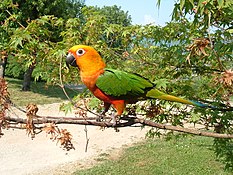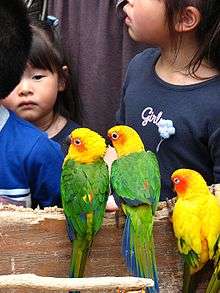Jandaya parakeet
The jandaya parakeet or jenday conure (Aratinga jandaya) is a small Neotropical parrot with green wings and tail, reddish-orange body, yellow head and neck, orange cheeks, and black bill, native to wooded habitats in northeastern Brazil. It is a member of the Aratinga solstitialis complex of parakeets very closely related to, and possibly subspecies of the sun parakeet.
| Jandaya parakeet | |
|---|---|
 | |
| Scientific classification | |
| Kingdom: | Animalia |
| Phylum: | Chordata |
| Class: | Aves |
| Order: | Psittaciformes |
| Family: | Psittacidae |
| Genus: | Aratinga |
| Species: | A. jandaya |
| Binomial name | |
| Aratinga jandaya (Gmelin, 1788) | |
| Synonyms | |
|
Psittacus jandaya | |
The bird has a wide range, but is locally rare in the wild; they are common in aviculture, where they are known as "jenday conures".
Taxonomy
The first description of a bird called "jendaya" was by German naturalist, Georg Marcgraf, during his 1638 expedition through Dutch Brazil.[2] [Notes 1] It was first classified by German naturalist Johann Gmelin as Psittacus jandaya in his Systema Naturae, 1788, based on Psittacula brasiliensis lutea of Brisson,1760; "jandaya" of Ray,1676; and "yellow-headed parrot" of Latham, 1781. In 1916, American ornithologist Robert Ridgway reclassified the 21–22 species of neotropical parakeets in genus Conurus into four genera, placing jandaya into the genus Aratinga.
The specific name was derived from: Aratinga: "bright macaw" from Ará – Old Tupi, big noisy bird (macaw) + tinga – Old Tupi, bright. jandaya (originally jandaia): Old Tupi, small parrot (conure).[3]
Jandaya is a member of the Aratinga solstitialis complex of parakeets very closely related to, and possibly subspecies of, the sun parakeet in genus Aratinga of smaller parakeets, one of numerous genera of New World, long-tailed parrots in tribe Arini, which also includes the Central and South American macaws. Tribe Arini together with the Amazonian parrots and a few miscellaneous generals make up subfamily Arinae of Neotropical parrots in family Psittacidae of true parrots.
Ornithologist Thomas Arndt lists this bird as a subspecies of golden-capped parakeet.[4]
The taxonomy of this and related species and genera have been problematic; more information may be found under Sun conure#Taxonomy.
Based on size, morphology, and plumage, this species is believed to be a close living relative of the extinct Carolina parakeet, possibly the closest, though that has not been confirmed by molecular phylogenetics[5] which found the nanday parakeet to be the Carolina parakeet's closest living relative among the species tested. The plumage of this bird is very close to that of the Carolina's and can be distinguished from the Carolina parakeet by having a yellow neck and shoulders, and a black beak instead of a buff-colored beak as the Carolina parakeet had.
An earlier molecular study found the jandaya's closest relative to be the golden parakeet.[6]

Description
The jandaya parakeet is a small, long-tailed parakeet with the reddish-orange body, green wings, vent and tail, yellow head, neck, and shoulders, orange cheeks, black bill, whitish periophthalmic ring, and dark eyes. The ends of the tail feathers are tinged in blue. It measures 30 cm (12 in) in length and weighs 125–140 gm.
The jandaya parakeet has a very loud, shrill call.
Distribution and habitat
It has an extremely large range in northeastern Brazil in the states of Piaui, Maranhao, Tocantins, and Ceara, and portions of Pará. It is found in lowland deciduous woodland and palm groves.
Behavior and diet
In the wild, it has a predilection for various fruits including mango and cashew apples, as well as palm nuts, and an unfortunate attraction to plants cultivated by humans (rice, maize, members of the family Annonaceae, etc.). Things that are toxic to jandaya parakeets include chocolate, caffeine, and a chemical often found in avocados.[7]
Jandaya parakeets nest in tree hollows, typically choosing a location at least 15 m (50 feet) from the ground.[8] In captivity, the hen lays three to six eggs, which she then incubates for roughly 26 days. The young are fed by both parents, and fledge after two months.[9]
Conservation and threats
The species is listed as least concern by IUCN. It is listed on CITES Appendix II. It is protected under Brazil Wildlife Protection Act (1967), export and trade forbidden. The global population has not been quantified, but the bird was described as "rare" in two field surveys in 1996[10] and 2007,[11] in parts of its former range.
Aviculture
This bird is sometimes called, rather colloquially, yellow-headed conure or flaming conure.
The jandaya parakeet can live 30 years in captivity.[12] Like many of the parakeet species commonly kept as companion parrots, jandaya parakeets are known for their intelligence, and can be trained to perform pet-like behaviors. These small parrots can often learn to mimic sounds including words and even phrases.
Jandaya parakeets are social and generally stay in flocks. They are very loud and call to each other frequently.[12]
References
- BirdLife International (2012). "Aratinga jandaya". IUCN Red List of Threatened Species. 2012. Retrieved 26 November 2013.CS1 maint: ref=harv (link)
- Piso, Willem (1648). Historia Naturalis Brasiliae. p. libri octo,9,p. 206.
- Jobling (2009). Helm Dictionary of Scientific Bird Names. Christopher Helm Publishers Ltd.
- Arndt, Thomas (2000). Lexicon of Parrots. Arndt-Verlag.
- Kirchman, Jeremy; Schirtzinger, Wright (April 2012). "Phylogenetic Relationships of the Extinct Carolina Parakeet from DNA Sequence Data". Int. J. Ornithol. 129 (2).
- De Lucca, E.J.; Shirley, L.R.; Lanier, C. (1991). "Karyotype studies in twenty-two species of parrots". Review of Brazilian Genetics (14): 73–98.
- https://lafeber.com/pet-birds/foods-toxic-pet-birds/
- "Jenday Conure (Aratinga jandaya) – Wild Parrot Status". World Parrot Trust. Retrieved 21 March 2009.
- "Jenday Conure, Janday Conure, Jandaya Conure, Yellow-headed Conure, Aratinga jenday". animal-world.com. Retrieved 21 March 2009.
- Stotz, D.F.; et al. (1996). Neotropical birds: ecology and conservation. Chicago: U. Chicago Press.
- de Faria, Iubatã Paula (2007). "Registros de aves globalmente ameaçadas, raras e endêmicas para a região de Vicente Pires, Distrito Federal, Brasil". Revista Brasileira de Ornitologia. 15: 117–122.
- "Archived copy". Archived from the original on 29 June 2016. Retrieved 1 March 2011.CS1 maint: archived copy as title (link)
Notes
- Quintus: Jendaya: funt magnitudine merulae aut minoris Turdelae; roftro & cruribus nigris, oculis nigricantibus, circulo aureo, exterius albo: dorsum, alae, & cauda, ut & anus, viridibus pennis vestiuntur quibus thalassinus mixtus: extremitas alarum quodammodo nigrefcit. Totum caput, collum & pectus flavi coloris funt, cui luteus intermixtus
External links
- "Jandaya parakeet - BirdLife Species Factsheet". BirdLife International (2008). Retrieved 3 January 2009.
